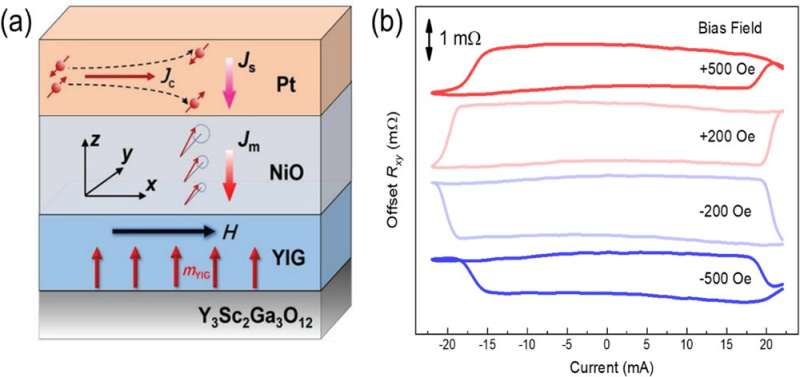(a) Schematic diagram and (b) Experimental confirmation of the MTT effect. (a) Spin current in Pt is transformed as magnon current in NiO and then transfers spin angular momenta to Y3Fe5O12 (YIG). (b) Anomalous Hall resistance as a function of applied current under different applied fields. Magnetization switching loops are observed with opposite switching directions under opposite fields. (Image by IOP)
Spin torque provides convenient electric means to efficiently control magnetizations. It can usually be produced by spin-polarized current or pure spin current via spin Hall effect. The former and the latter are named as spin transfer torque (STT) and spin orbit torque (SOT), respectively. Utilizing these tools, people have developed the second generation STT-MRAM (Magnetic Random-Access Memory) with in-plane magnetic anisotropy, the third generation STT-MRAM with perpendicular magnetic anisotropy and the fourth generation SOT-MRAM among other spintronic devices and chips. Moreover, perpendicular STT-MRAM chips have been demonstrated and close to large-scale applications.
Collective excitations in spin-ordered systems or spin waves or magnons have been proved to transmit spin angular momentum over a long distance only by the adjacent coupling between local spins without flowing charged electrons, shedding light on a Joule-heating-free version of microelectronics. Magnons are thus expected to serve as an idea carrier for transmitting, storing, and processing spin information.
Before that, it becomes an open and frontier question for magnonics and spintronics whether magnons can transfer spin torque or not besides of the pure spin current. The answer to this question determines the possibility of developing pure magnonic manners to control magnetizations. Although the magneton transfer torque (MTT) effect has been theoretically studied, its accurate confirmation in experiments is still challenging.
Dr. Guo Chenyang, Associate Prof. WAN Caihua and Prof. HAN Xiufeng etc. in M02 group at the Institute of Physics of the Chinese Academy of Sciences recently designed an insulating magnetic heterostructure Y3Fe5O12/NiO/Pt with perpendicular magnetic anisotropy (PMA) in which the MTT effect has been unambiguously confirmed by the current-driven magnetization switching phenomenon.
In this structure, platinum as a heavy metal with strong spin orbit coupling is responsible for producing pure spin current via applying a current through it. As an antiferromagnetic insulator, NiO is used to convert electronic spin current to magnonic spin current (magnon current). The insulating Y3Fe5O12 (YIG) with PMA is applied as a magnon sink. Once the MTT exists, the magnetization of YIG can be tilted or switched by the magnon current.
As insulators, YIG and NiO can safely prevent electronic current from penetrating into them, so any influences from electronic spin current can be eliminated. At the same time, perpendicular YIG cannot be deterministically switched by an in-plane Oersted field, which can fully rule out a possibility of the Oersted mechanism. Therefore, only the magnon current through the antiferromagnetic NiO has capability of exerting torque on YIG and causes its magnetization switching.
This observation thus unambiguously verifies the MTT effect. According to the characteristics of SOT-induced magnetization switching, if the applied in-plane field is reversed, the SOT switching direction should also be reversed. This feature can be an additional indication for the MTT effect.
Therefore, this work clearly establishes the physic scenario for the magneton transfer torque effect, and shows that the MTT is useful as a tool to control magnetization of magnetic insulators, which can advance the development of pure magnon memory and logic devices.
The related work has been published in Physical Review B entitled "Switching perpendicular magnetization of a magnetic insulator by magnon transfer torque."
More information: C. Y. Guo et al, Switching the perpendicular magnetization of a magnetic insulator by magnon transfer torque, Physical Review B (2021). DOI: 10.1103/PhysRevB.104.094412
Journal information: Physical Review B
Provided by Chinese Academy of Sciences
























